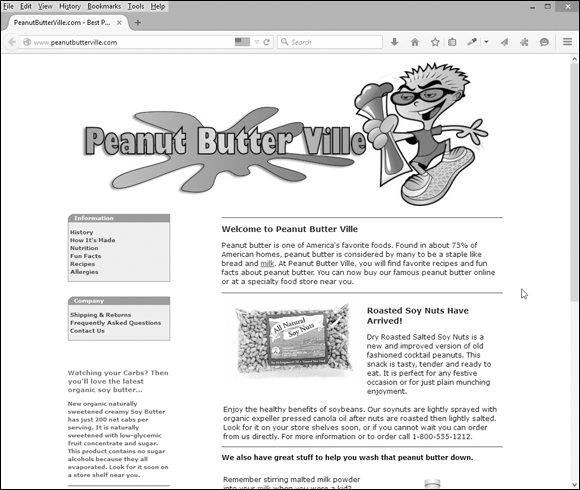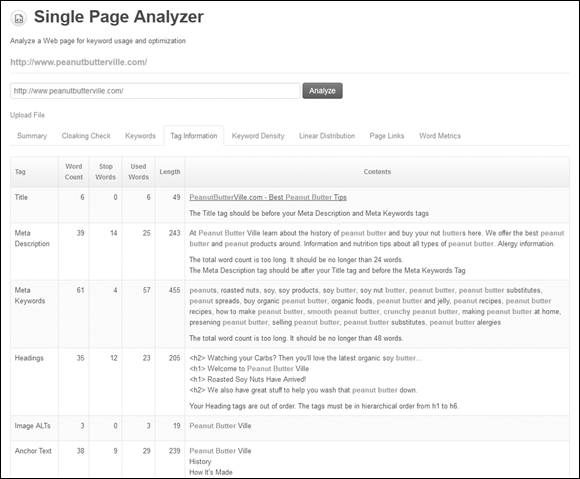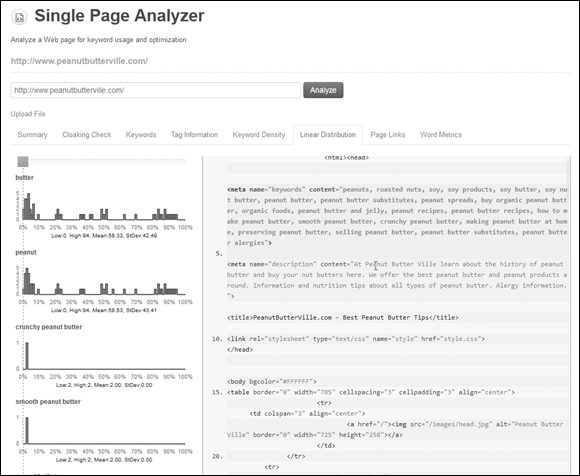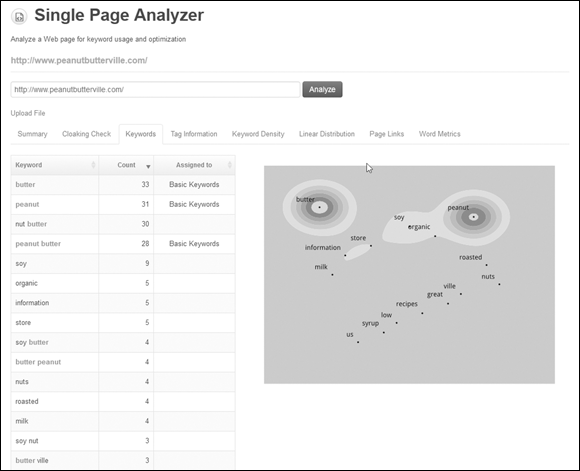Chapter 5
Adding and Maintaining Keywords
In This Chapter
- Figuring out keyword densities
- Adjusting keywords
- Updating keywords
- Using tools to aid keyword
If you've been doing what we suggest in the previous four chapters of this minibook, you’ve brainstormed, done your research, categorized your keywords, and created landing pages (the web page the user comes to when clicking a link) for your subject categories. So now what? Now you actually get to add keywords.
There is an art to placing keywords on your website. You can’t simply type car, car, car, car, car, car again and again. For one thing, that’s considered spam and will get your site pulled from the search engine index. (For our purposes, spam is any type of deceptive web technique meant to trick a search engine into offering inappropriate, redundant, or poor-quality search results. For more details, see Book I, Chapter 6.) For another thing, a user who sees “car, car, car, car … ” would immediately hit Back on the browser window because your site is obviously not going to be of any use to him. Remember, you want to keep people on your website so that they will stick around and be converted from a visitor to a customer (or however your website defines a conversion). To do that, you have to create searchable, readable content for your website.
But what do you do with those keywords we make you gather in Chapter 1 of this minibook? In this chapter, we talk about how to distribute them on your pages and how to determine the number of times you need to use them. We also discuss how to maintain your keywords. Unfortunately, the Internet is ever changing, and so is the market. To maintain your relevancy, you also have to adjust and update your keywords regularly, both in importance and frequency. But not to worry: There are tools out there that help you measure your keywords’ performance and analyze your competition’s keywords, and we show you how to use them.
Understanding Keyword Frequency and Distribution
Keyword frequency and distribution are two factors that marketers look closely at in SEO land. Keyword frequency refers to the number of times a keyword is used on a web page. Any word (or phrase) is considered a keyword if it's used at least twice on the page. (Note that search engines do not include stop words such as and, the, a, and so forth as keywords, although they may be part of keyword phrases.)
Keyword distribution measures whether a keyword is evenly distributed throughout the page and the site. It's important to make sure that your keywords appear throughout the page but especially right up front because search engine spiders generally put more weight on the first 200 words, including words in your navigation, headings, and so on. Make sure to remember to sprinkle the keywords evenly throughout the page in a normal writing fashion. Natural-sounding text is easier to read and scores better with search engines.
You can visualize keyword distribution if you imagine all the content of a web page arranged horizontally in a box, so that the beginning of the page is at the far left and the last words on the page are at the right edge. Figure 5-1 shows the distribution of a keyword on a given page. These charts show how often a keyword phrase [peanut butter] occurs many times near the beginning of the page, a couple of times near the middle of the page, with another sprinkling of uses near the end. Although a more even distribution would be better, search engines could tell from this distribution that the word [peanut butter] is an important keyword for this web page.

Figure 5-1: A linear distribution chart for a keyword across a web page.
In order to have proper keyword distribution, you can’t clutter up your page with keywords or just dump them on the page. When writing your text, form sentences that use those keywords. Remember what we said about keyword phrases as well. Search engine users are getting more sophisticated these days and they’re entering search queries that contain four or more words instead of just two or three. If you’re a good writer, you’re going to have to tame some of those habits you learned while writing papers. Good writers are encouraged to use synonyms and rephrase things to keep from being too repetitive. This makes a document easier to read, surely, but it won’t help with your site rankings. Because your search engine ranking is going to be measured using a math equation, it’s better to think of your site in terms of supplying the equation with numbers.
For instance, if you want to rank high for a query like [classic cars], you’re going to have to keep using the words classic cars in your page instead of using these and them and so forth. Use discretion when doing this; otherwise, your page could become unpleasant to read. A good example of how to properly spread keywords is this book. Notice how many times we say a particular word, like keyword, and how we distribute it through the text. We don't say “Choose your keywords during your keyword research for keyword optimization purposes using keyword tools.” That level of repetition is unnatural-sounding. Instead, we mention keywords every now and then, when it’s appropriate. On the other hand, we don't just say keyword once and then spend the rest of our time trying to find flowery ways to refer to keywords. Your competition is a good way to get an idea of what looks natural to search engines. For more on how to analyze your competition's pages, read Book III, Chapter 1.
- Once in the Title tag
- Once or twice in the description Meta tag (in the HTML code)
- Once or twice in the keywords Meta tag (in the HTML code)
- Once in the first sentence of on-page (user visible) text
- Twice in the first 200 words (including the first sentence)
- Once each in paragraphs two, three, and four
- Once or twice in the last paragraph
On the flip side, there is such a thing as using too many keywords — that's how you venture into the realm of spam through keyword stuffing. (Refer back to spam definitions in Book I, Chapter 6.) Remember our sample sentence about keywords from a few paragraphs ago? That's a stuffed sentence. There’s no guaranteed magic number for keyword frequency, but it’s a good rule of thumb to keep your keywords below 5 percent of the total number of words on the page. The better way to do it is to make it sound natural as compared to your competition. Use a keyword too often, and you could trip an alarm on a keyword-stuffing filter. Keywords repeated too often also work against user retention and could bring down the conversion rate. For a commercial website, you want to keep customers around so they’ll make purchases, and you risk driving them away with too much repetition. For an informational or reference website, the goal is to have as many visitors as possible stick around and read the information available. Badly written text does not make someone want to stay on your website. Figure 5-2 shows a made-up example of a web page with keyword stuffing.

Figure 5-2: This web page needlessly repeats the keyword [peanut butter]. Not only is this bad writing, but also it could be considered keyword stuffing.
Adjusting Keywords
After you optimize your website for your selected keywords, be aware that your job is not done. Search engine optimization involves continual monitoring, testing, and tracking. You need to keep track of how your keywords are performing as you go along. If a keyword is not drawing in as much traffic as you think it should be, or it’s drawing in the wrong kind of traffic (visitors who don’t convert), it’s time to go in and change it. (This is why you do a bunch of research into your competition, and look up synonyms while you're at it.)
If a keyword is not working out, sitting around and hoping it eventually will is not going to increase your ranking. SEO is not an exact science; it requires tweaking, fixing, and adjusting things. If one keyword is not working for you, perhaps its synonym might. If you find that you're getting traffic but no conversions, that's a sign that you need to look deeper into whether this is a useful keyword or if you're just wasting time trying to fight that battle.
It's more than okay to go in and adjust your keywords as needed. Do some testing between different keywords and compare the results to find your best performers. If a word’s not working for you, stop using it! There are words out there that will bring your targeted audience, and all you need to do is make the proper adjustments to find them.
Updating Keywords
The thing about keyword maintenance is that it’s not an exact science. There is no one guaranteed keyword out there that will always bring you a ton of traffic today and into the future. For one thing, no one knows what the Internet will look like two years from now, let alone five or ten. Vernacular changes very rapidly. In 2000, Google was a small upstart search engine; today, Google so dominates the industry that it’s become a word in the dictionary and is often used as a verb. You can’t stay still in the online world. Things that are common sense to us today might not stay that way.
For example, in the late ’90s, you used a cellular telephone. Nowadays, it’s a cell phone. If you’re abroad, you don’t use a cell phone, you use a mobile. A term that made sense as a keyword five years ago might not make sense today. The moral of the story is that you can’t do your keyword research once and then say you’re done. You have to keep researching as you go along, especially if you’re making plans for the long term.
Using Tools to Aid Keyword Placement
Just as there are tools for measuring how often a keyword is searched (which we cover in Chapter 4 of this minibook), there are also tools out there that aid you in researching keyword frequency and distribution on a certain page. You want to use these tools to check out the competition. You need to know not only what keywords your competitors are using but also in what frequency.
There are a couple of ways you can go about this. You can count the keywords by hand and probably drive yourself nuts. Or you can use a helpful tool called the Single Page Analyzer. The Single Page Analyzer measures and analyzes how effectively Meta tags are written, how often you are using your intended keywords compared to the total number of words on your web page, and other useful word metrics about the page. This tool measures frequency and prominence and graphs the distribution of keywords. Figures 5-3, 5-4, and 5-5 show a few things about a page's keywords reported by the Single Page Analyzer of the SEOToolSet.

Figure 5-3: The Single Page Analyzer looks at a page's Meta tags and highlights the use of keywords.

Figure 5-4: The Single Page Analyzer reports the linear distribution of a keyword on a page.

Figure 5-5: The Single Page Analyzer also maps prominent words used on the page in relation to one another.
You can find many page analyzers out there, but the one we discuss is available within SEOToolSet Lite, which you can subscribe to for free at http://www.seotoolset.com/tools/plans-pricing/. To use it, choose Single Page Analyzer from the Page Analysis menu, and then simply type your website’s URL into the query window. Click the Analyze button, and after a minute, you see a results page like the one shown in Figures 5-3, 5-4, and 5-5 for our training site, www.peanutbutterville.com.
The Single Page Analyzer shows your SEOToolSet Meta tag information under the Tag Information tab, as shown in Figure 5-3.
In this section of the report, under the heading Contents, you can see all the text the Single Page Analyzer found in your Title tag and Meta tags for this page. Title tags are what you name your web pages in the HTML coding of the site. Placing a keyword or keywords in your page titles is very important. The Meta description and keywords tags are other items in the HTML code at the top of each page. These are not visible to the user, but search engine spiders read them and use the words in these fields to help determine how relevant your web page is and where it should be ranked for search queries.
The Single Page Analyzer can let you know whether a title is too long or too short, too many or not enough keywords are used, and you’re in danger of a spam violation.
The next two tabs on the report reveal important information about keywords used on the page. For instance, you can see all the words and phrases that appear frequently on the page by using the Keyword Density tab. And the Linear Distribution tab shows how the Single Page Analyzer visualizes the linear distribution of your intended keywords throughout the page, as shown in Figure 5-4. Bigger bumps on the graph mean the keyword was used a lot in that part of the page.
In Figure 5-5, you see the prominent words used on a page in a visualization like a topographical map (under the Keywords tab). Words that are used the most appear as high elevations, or darker colors. How closely associated those words seem to be in the page’s content is represented by how closely the words are positioned on the map. The keyword map lets you see, at a glance, whether the page is hitting its primary keyword targets.
The more practice you have with researching, updating, and maintaining keywords, the less you need tools like the Single Page Analyzer. When you have more experience, you can look at a page and see if the keyword density needs tweaking, but it takes practice and patience to get to that point!

 Remember that search engines count every instance of a word on a web page (except if that word appears in a graphic — computers can’t “read” images). This includes all words in the article text plus words in headings, navigation elements, links, and HTML tags. Here’s an example, and remember this is just a recommended guideline, of how you might evenly distribute a main keyword throughout a page that had 750 words divided into five paragraphs:
Remember that search engines count every instance of a word on a web page (except if that word appears in a graphic — computers can’t “read” images). This includes all words in the article text plus words in headings, navigation elements, links, and HTML tags. Here’s an example, and remember this is just a recommended guideline, of how you might evenly distribute a main keyword throughout a page that had 750 words divided into five paragraphs:  Want to make sure a search engine doesn’t miss your keywords? You can draw more attention to keywords by applying special formatting, such as strong (
Want to make sure a search engine doesn’t miss your keywords? You can draw more attention to keywords by applying special formatting, such as strong (